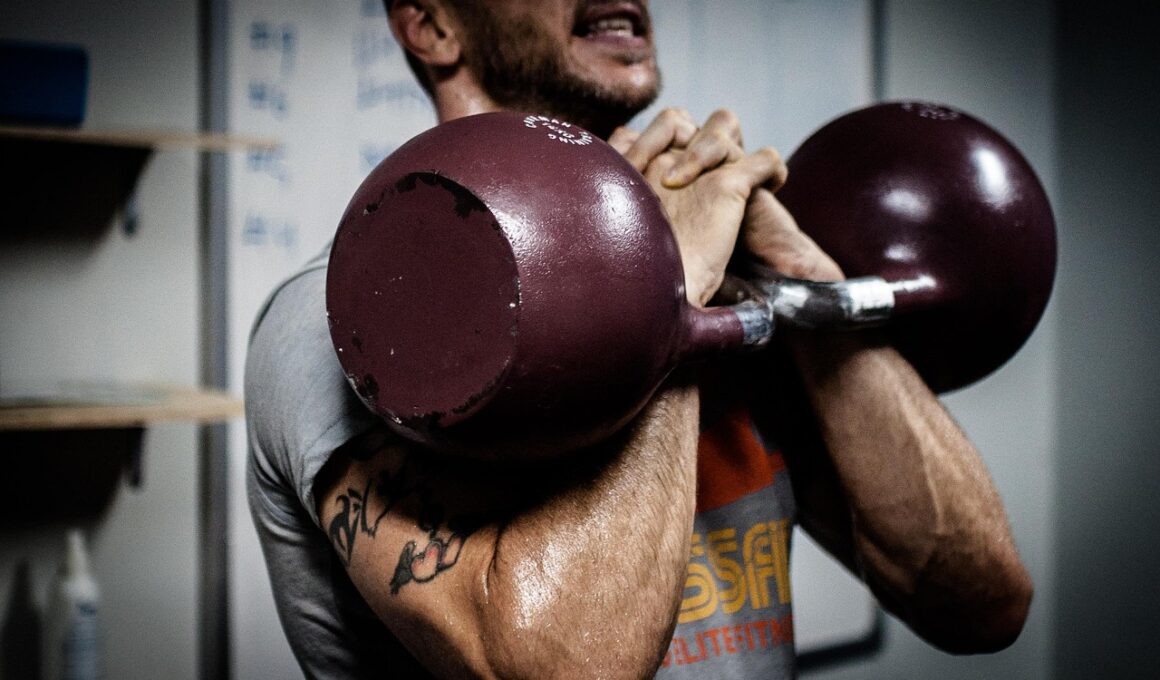Core Rehabilitation Exercises Using Kettlebells
Kettlebell training is a convenient and effective method for core rehabilitation. This approach combines resistance training with stability exercises, promoting overall strength and balance. Core stabilization is crucial for rehabilitating muscles and preventing injury. Targeted kettlebell exercises can improve muscular endurance through controlled movements, allowing focus on specific muscle groups involved in core stabilization. By engaging not only the abdominal muscles, kettlebells help activate surrounding stabilizers, providing a more holistic approach to recovery. Moreover, their unique shape can be beneficial to enhance grip strength and functional movement patterns. You can incorporate kettlebell workouts into your rehabilitation routine by adjusting the intensity and complexity of movements. The versatility of kettlebells can accommodate varying fitness levels, enabling progression or regression based on the individual’s ability. It’s essential to learn proper form to ensure safety and effectiveness during rehabilitation. By integrating kettlebells into your regimen, you stimulate strength and coordination, which translates to improved functional performance in daily activities. Adopting a structured kettlebell program can yield significant benefits during recovery from core injuries, making it a valuable asset in any rehabilitation strategy.
It is essential to understand the key benefits of incorporating kettlebell workouts into your rehabilitation plan. First, kettlebells promote increased strength through enjoyable dynamic movements. This helps foster a positive mindset essential for recovery and motivation. Engaging multiple muscles provides effective conditioning while decreasing recovery time. Additionally, kettlebell training promotes improved flexibility and mobility, which can prevent stiffness during rehabilitation. With greater range of motion, core muscles perform more efficiently, helping avoid future injuries. Furthermore, leveraging the unique weight distribution of kettlebells, you can challenge your stabilizing muscles as you perform exercises. The asymmetrical weight encourages core engagement, which is vital for recovery. The use of kettlebells also helps develop proprioception, assisting individuals in understanding their body positioning and movements. Such awareness plays a critical role in rehabilitation. The progression available with kettlebell training allows you to easily adjust weights as strength increases. This incremental challenge supports continual growth while decreasing risks associated with overtraining. You also engage your cardiovascular system with kettlebell workouts, providing a comprehensive approach to fitness that encourages well-rounded physical development during rehabilitation.
Effective Kettlebell Exercises for Core Rehabilitation
When it comes to effective kettlebell exercises for core rehabilitation, several movements stand out. The kettlebell swing is an excellent choice, effectively engaging the entire core while promoting dynamic movement patterns. Begin by focusing on form while gradually increasing weight to prevent injury. Another valuable exercise is the Turkish get-up, providing a comprehensive full-body workout that emphasizes core stability and mobility. This exercise can enhance coordination and strength, ultimately aiding recovery. Additionally, the windmill is a fantastic movement that targets obliques and enhances shoulder stability, essential for a balanced core. The plank with kettlebell row also promotes strong core engagement while challenging stability and creating a full-body workout. Finally, the kettlebell deadlift is an exceptional exercise for strengthening the posterior chain, crucial for overall core support and injury prevention. Remember to consult with a healthcare professional before engaging in these exercises to ensure safety and optimal recovery. By incorporating these rotational, dynamic, and stability-focused exercises into your program, you’ll foster an effective rehabilitation journey that develops a strong core. Start slowly and gradually progress in intensity as your strength and stability improve throughout recovery.
Form and technique are vital components in kettlebell training, especially during rehabilitation. Proper posture while executing kettlebell exercises maximizes effectiveness and minimizes the risk of injury. Start practicing in front of a mirror or with professional guidance to guarantee correct alignment and movement patterns. Keeping your core engaged throughout each exercise establishes a solid foundation, allowing for fluid transitions between movements. Concentrating on your breathing also plays an essential role; emphasize inhaling during preparation and exhaling during exertion. Additionally, modifying the kettlebell’s weight or selecting more approachable variations of exercises can facilitate safer practice. Discover what feels comfortable, and adjust accordingly to ensure you can maintain form as you progress. It’s possible to incorporate warm-up routines specifically targeting the core and surrounding muscles before diving into more challenging kettlebell workouts to enhance flexibility and mobility. Incorporating functional movements within your routine will also simulate those performed in daily life. This aids in building the necessary strength for improved overall performance and rehabilitation. Remember, every rehabilitation journey is unique, so continually monitor your progress and make adjustments to your weight, form, and intensity as needed to support effective recovery.
Integrating Kettlebell Training with Other Modalities
For optimal results in core rehabilitation, consider integrating kettlebell training with other modalities such as physical therapy, yoga, or Pilates. Combining these strategies creates a well-rounded approach that targets various aspects of recovery. Physical therapy ensures a tailored program focusing on specific needs, while kettlebell workouts enhance strength and stability. Yoga or Pilates can also facilitate improved flexibility and mental focus, vital during rehabilitation. This holistic approach can encourage a deeper awareness of your body, enhancing overall performance and fostering success in your recovery journey. Engaging in diverse activities will prevent monotony while maintaining motivation throughout the rehabilitation process. Additionally, focusing on nutrition is essential during recovery to fuel your body adequately. Consuming a balanced diet can enhance performance during kettlebell workouts while promoting tissue repair. Staying hydrated is crucial for efficient muscle function and recovery, so ensure water intake remains a priority. As you progress through your rehabilitation plan, regularly assess your fitness level and continue adjusting your routine to suit evolving personal goals. Finding the right balance between kettlebell training and other methods will create a comprehensive program that maximizes recovery and promotes long-term success.
Consistency and commitment are fundamental to succeeding in core rehabilitation using kettlebells. Ensure you allocate sufficient time each week to practice kettlebell workouts while balancing your rehabilitation efforts with other training modalities. A well-structured schedule enables focused practice on specific exercises while giving your body adequate rest and recovery. It’s important to listen to your body; if you feel any discomfort or pain, adjust your intensity or stop practicing until you can comfortably resume. Also, consider approaching rehabilitation with a positive mindset, as this can significantly impact progress and overall experience. Having clear goals can help you stay motivated while measuring your results over time. Engage in self-reflection to understand what works best for you and make needed adjustments. Joining a community, either in-person or online, can provide additional support and encouragement during your journey. Sharing your experiences and learning from others can enhance motivation and offer new insights into kettlebell training techniques. Celebrate your achievements, whether they’re minor or major milestones, to keep your spirits high and focus on maintaining consistency as you rehabilitate and strengthen your core effectively. The journey may be challenging, but the rewards of enhanced stability and strength are undeniably worth it.
Conclusion
In conclusion, kettlebell training serves as an excellent tool for core rehabilitation that fosters strength, stability, and flexibility. By incorporating specific kettlebell exercises into your recovery routine, you can effectively target core muscles while enhancing overall physical performance. Proper form and gradual progression are critical to ensuring safety and success throughout the rehabilitation process. Integrating kettlebells with other modalities, such as physical therapy, yoga, or Pilates, can enhance your journey and overall results. Always listen to your body and make adjustments to your training regimen based on your evolving needs and abilities. Staying motivated and focused on your goals will contribute significantly to your recovery process, allowing for consistent advancements and achievements. Remember that patience is essential, as building core strength requires time and effort. Celebrate every success and maintain a positive attitude to encourage progress and recovery. Commit to a regular kettlebell workout schedule, adjust exercises as needed, and gradually increase workload, ensuring proper rest between sessions. The resilience you develop throughout this journey can translate into numerous areas of your life, making it a rewarding and transformative experience. Start your kettlebell journey today and witness the incredible benefits it can provide for core rehabilitation.
Through the use of kettlebells, the journey to a healthier, stronger core becomes an engaging pursuit filled with rewarding experiences.


